France faced Andorra in matchday six of the Euro 2020 Qualifiers in what seemed to be far from an evenly matched game. With the world champions aiming to retain the top spot from Turkey in group H, surely Raphaël Varane and co. were looking to dominate the game and win big. And indeed, they absolutely dominated the extremely one-sided game with France having 84% of the possession, evidence of how unmatched these two teams were.
With this 3-0 win, France stay on top in group H ahead of Turkey who also got a big win against Moldova yesterday.
We will take a closer look at how both teams set their tactics up in this tactical analysis.
Lineups

France (4-2-3-1)
Deschamps deployed his team in a similar system for this game having crushed Albania 4-1 in their previous game. Still using a 4-2-3-1 system, there were four changes made in terms of personnel.
A pair of defensive-minded full-backs, Benjamin Pavard and Lucas Hernández both sat in the bench in this game. Léo Dubois and Lucas Digne started at the right-back and the left-back berths respectively – both of whom possess excellent attacking qualities very much needed to help France unlock Andorra’s stubborn defence.
Again, Deschamps played two box-to-box midfielders in this game with Corentin Tolisso once again starting, partnering with Moussa Sissoko, who replaced Juventus’ Blaise Matuidi.
Lille’s wonderkid Jonathan Ikoné made his way into the starting 11 for this game, replacing Thomas Lemar. The former started as a right-winger, while Kingsley Coman was moved to play on the left side of the wing.
This was certainly a team very much suited for an aggressive, attacking mentality setup.
Starting XI: Lloris – Dubois, Varane, Lenglet, Digne – Sissoko, Tolisso – Ikoné, Griezmann, Coman – Giroud
Bench: Matuidi, Maignan, Lemar, Areola, Zouma, Nzonzi, Fekir, Guendouzi, Pavard, Ben Yedder, Hernández
Coach: Didier Deschamps
Andorra (4-4-2)
There didn’t seem to be much change at all to the tactics for Andorra. They used the same approach of sitting back and trying their luck on the counter as they did in the fifth matchday against Turkey, which seemed to be quite effective in preventing them from scoring loads of goals despite having 85% of possession throughout the game. They set up with a flat 4-4-2.
Only one change was made in terms of personnel with Jesus Rubio starting in the game as a right-back, replacing left midfielder Victor Rodríguez. Moisés San Nicolás was moved to the left-back position while Joan Cervós was pushed into the left midfielder spot.
Starting XI: Gomes – Rubio, Llovera, Lima, San Nicolás – Clemente, Vales, Rebés, Cervós – Vieira, Martínez
Bench: E. Garcia, M. García, Ferré, Moreno, J. Rubio, Martinez, Pires, Rodríguez, Aláez, Gómez, Sánchez
Coach: Koldo Álvarez
Andorra’s defensive persistence
Andorra knew very well their opposition’s ability, especially in attack. They set out to defend deep from the get-go.
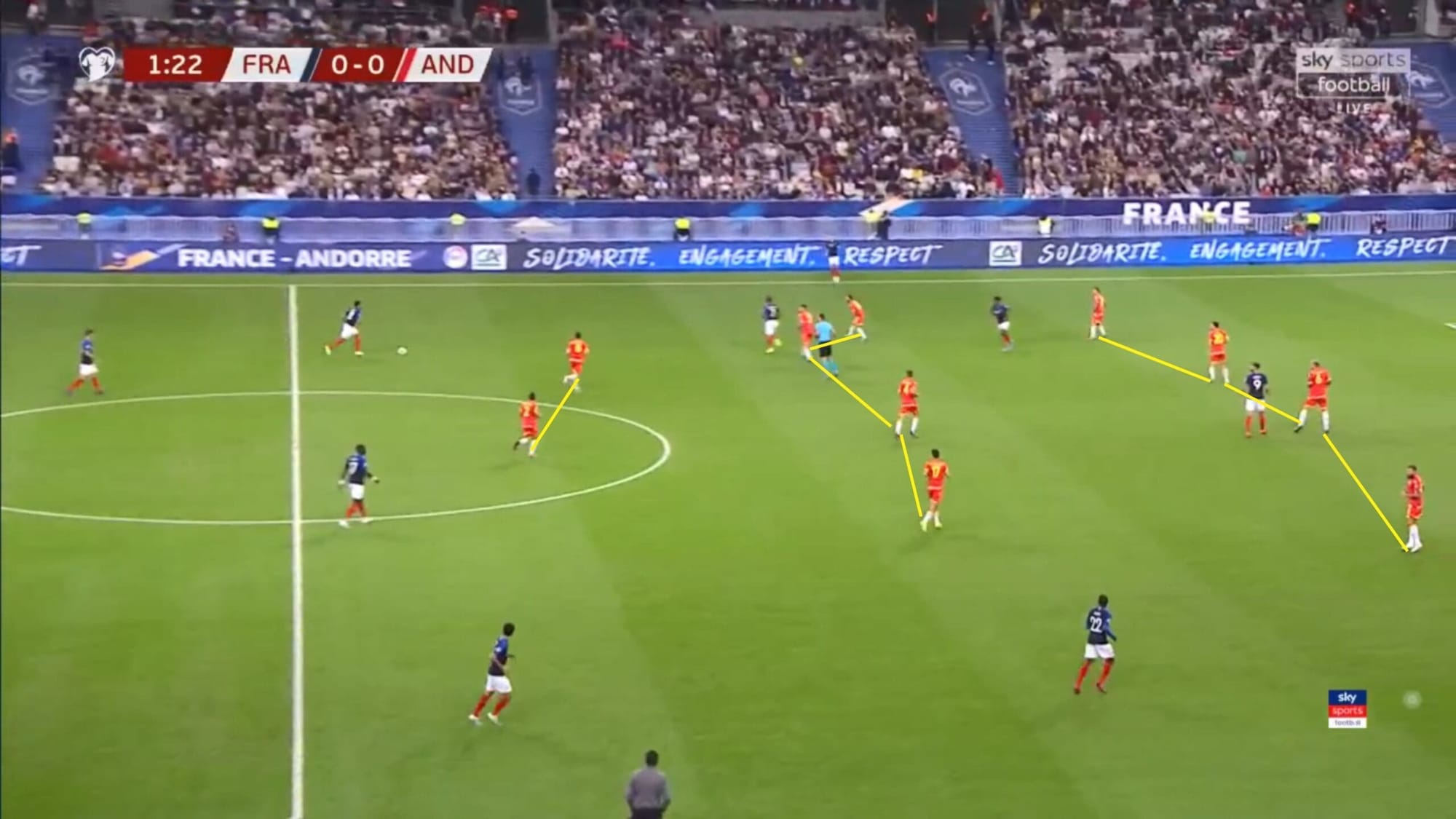
As you can see from the picture above, Andorra defended with a low block, with ten men behind the ball and below the halfway line. Though this ultra-defensive mentality made it very hard for the home team to break through their defence, this also hurt their chance of creating some damage on the other half of the pitch as they were basically being pinned deep inside their own half.
The away team were rather conservative and not very aggressive in defence. They tended to follow and move to where the ball was going without really trying to give pressure to the ball-carrier unless they saw a chance of doing so due to the French players’ mistakes, heavy touches, or when the ball was played backwards like in the picture below.
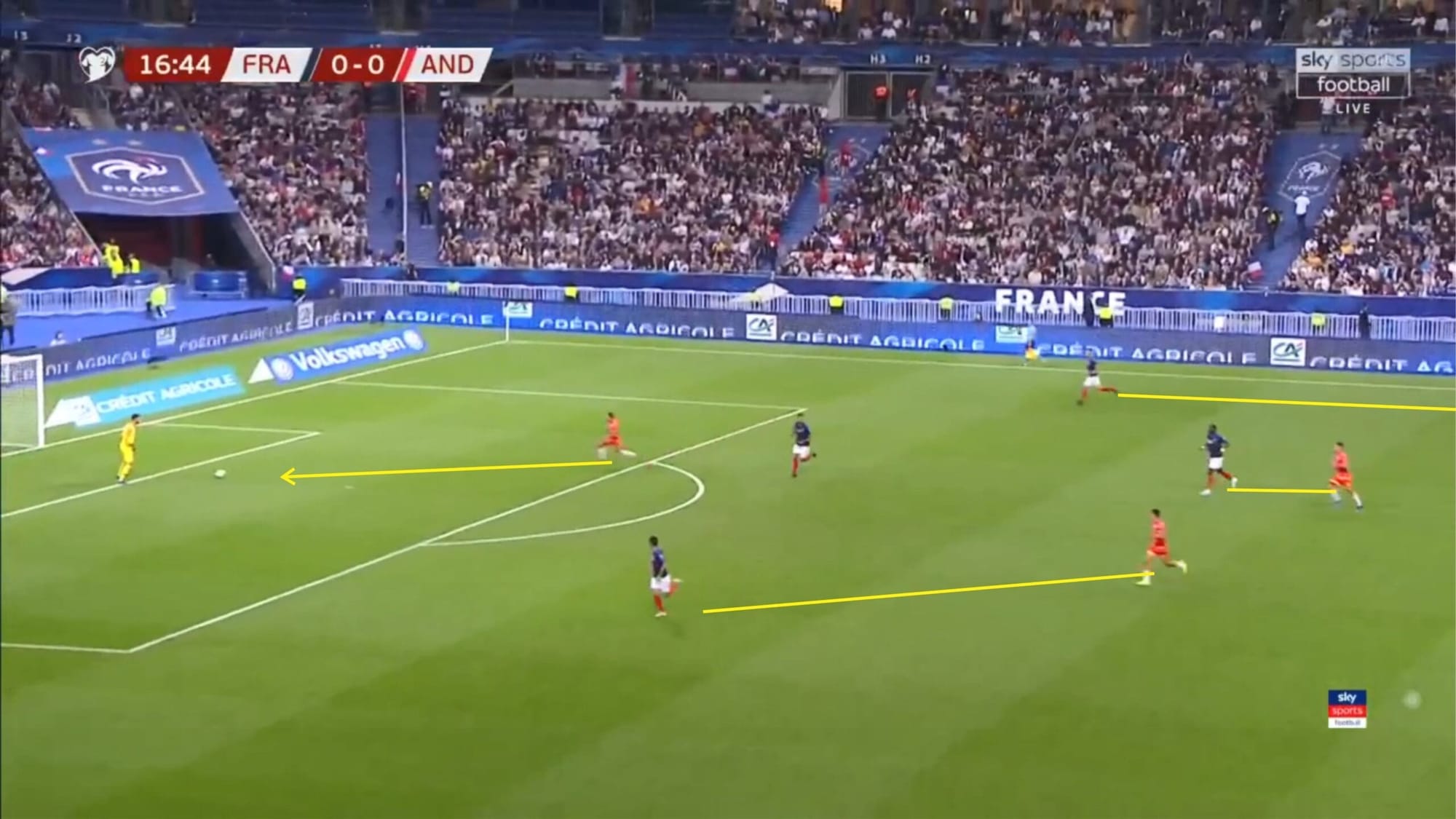
Andorra were quite narrow and compact in defence. They’d usually try to create an overload on the flank by concentrating their players on that side. In this picture below, we can see how Andorra attempted to do so.
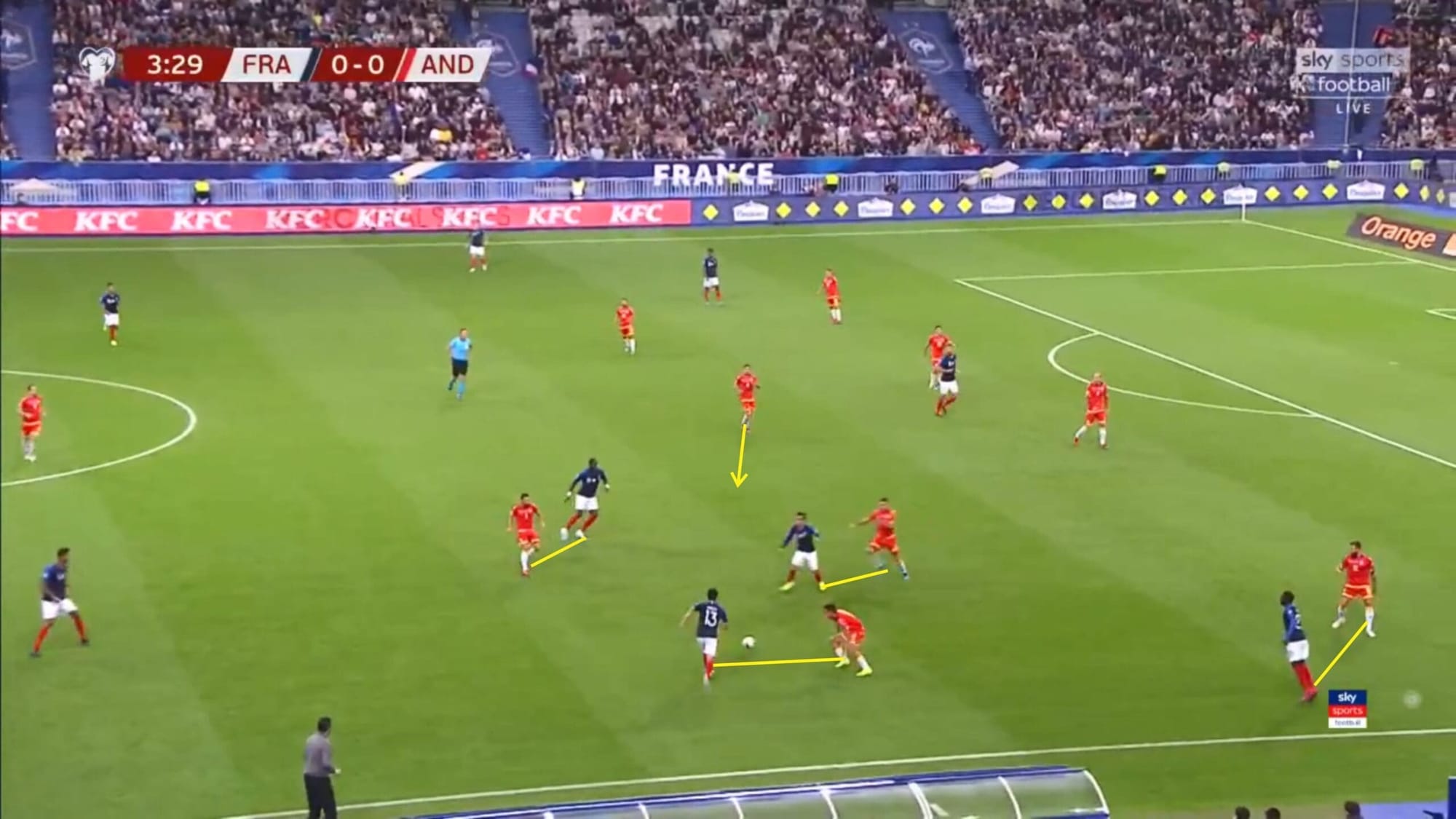
In this picture above, Andorra’s left-sided striker Martínez dropped back, moved slightly wider and followed Sissoko as the latter attempted to find spaces in more advanced areas. Dubois was shadowed by the left midfielder while the left-sided centre-mid followed and marked Antoine Griezmann when the latter dropped deep to link up. Ikoné, meanwhile, was marked by the left-back. We can also see the right-sided centre-mid trying to move closer to the left side to provide numerical superiority on that part of the pitch – creating an overload, isolating the ball-carrier, and preventing progression of the ball.
Although this was the case, France seemed to still be able to find ways to slip past Andorra’s defence. This was mostly due to Andorra’s slowness when moving their defence once the ball was switched to the other side of the field and France’s excellent speed when moving the ball around.
Aside from those two, it also seemed very clear that the French players were on another level when compared to their opposition in terms of overall quality, especially as individuals. This could be seen by the way the French players tended to improvise whenever they entered a difficult situation or when they saw a chance to exploit the opposing team’s weakness.
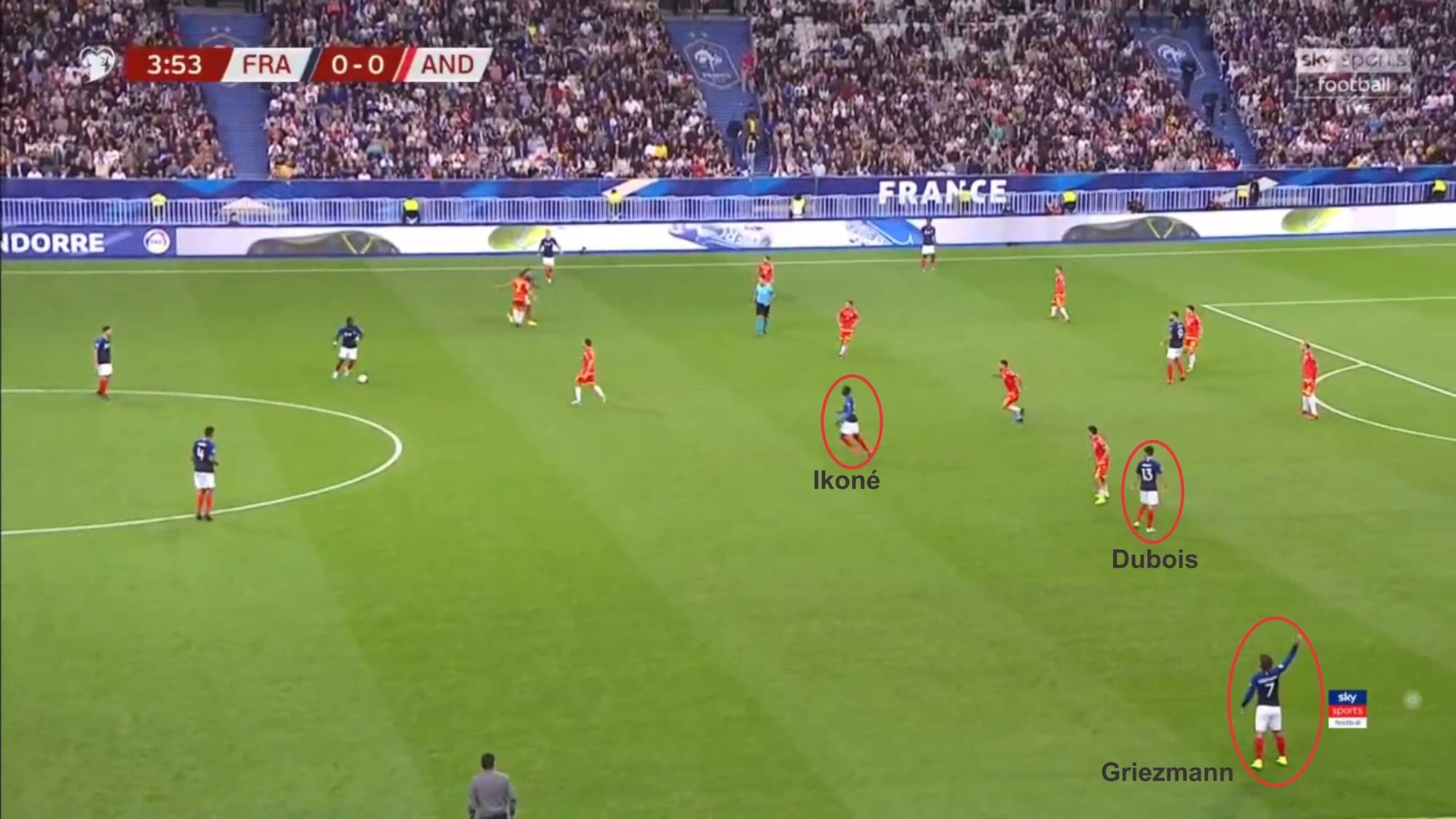
France’s aggressive attack
France seemed to throw at least six men up front when going forward: the two full-backs stretching the defence and providing width, the two wingers sitting in the half-space, target man Olivier Giroud who stayed central, and Griezmann who roamed freely across the frontline as you can see in the picture below (orange circles).
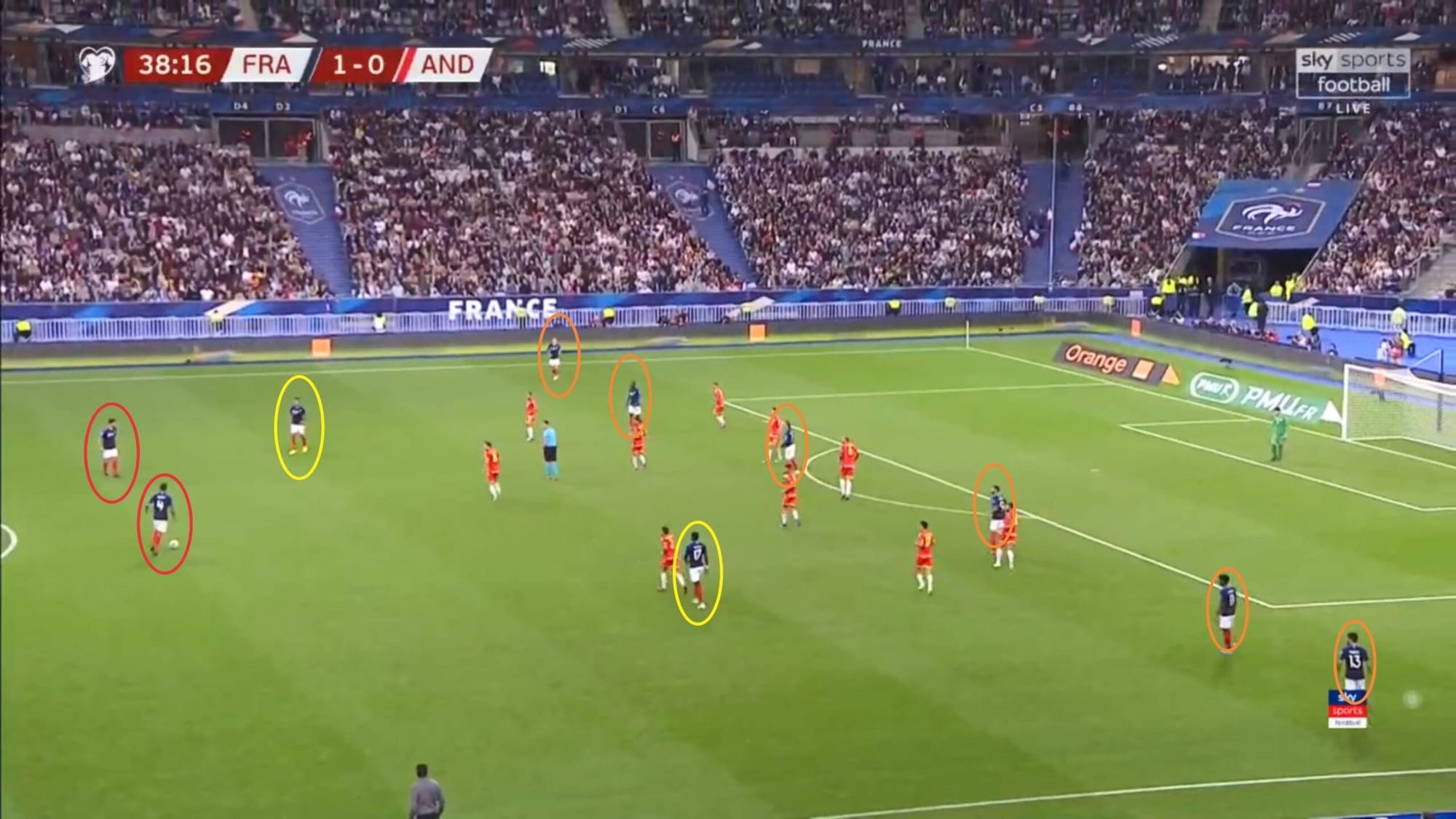
The two centre-midfielders were quite flexible as well (yellow circles). Most often these two centre-mids stayed a bit closer to the centre and acting as the connector between the lines and from one flank to the other.
Now you can also see from the picture that Andorra were very compact and narrow in defence and they did defend in numbers. Advancing through the middle seemed almost impossible but there were quite generous amounts of spaces out wide. Again, as mentioned previously in this tactical analysis, Andorra were quite vulnerable when France switched the play quickly due to their slowness in moving their block.
We can also see that Andorra were completely pinned deep inside their own half in this picture. All ten players were standing in and around their defensive third. This was, of course, a clear invitation for the two centre-backs of France to push higher up to support the attack, not just adding the number of support for the attacking players, but also pressuring Andorra in their own half, making it difficult for them to even get out of their own half whenever the ball was won. All ten outfield players of France were above the halfway line, facing all ten outfield players of Andorra who were trying to weather the storm.
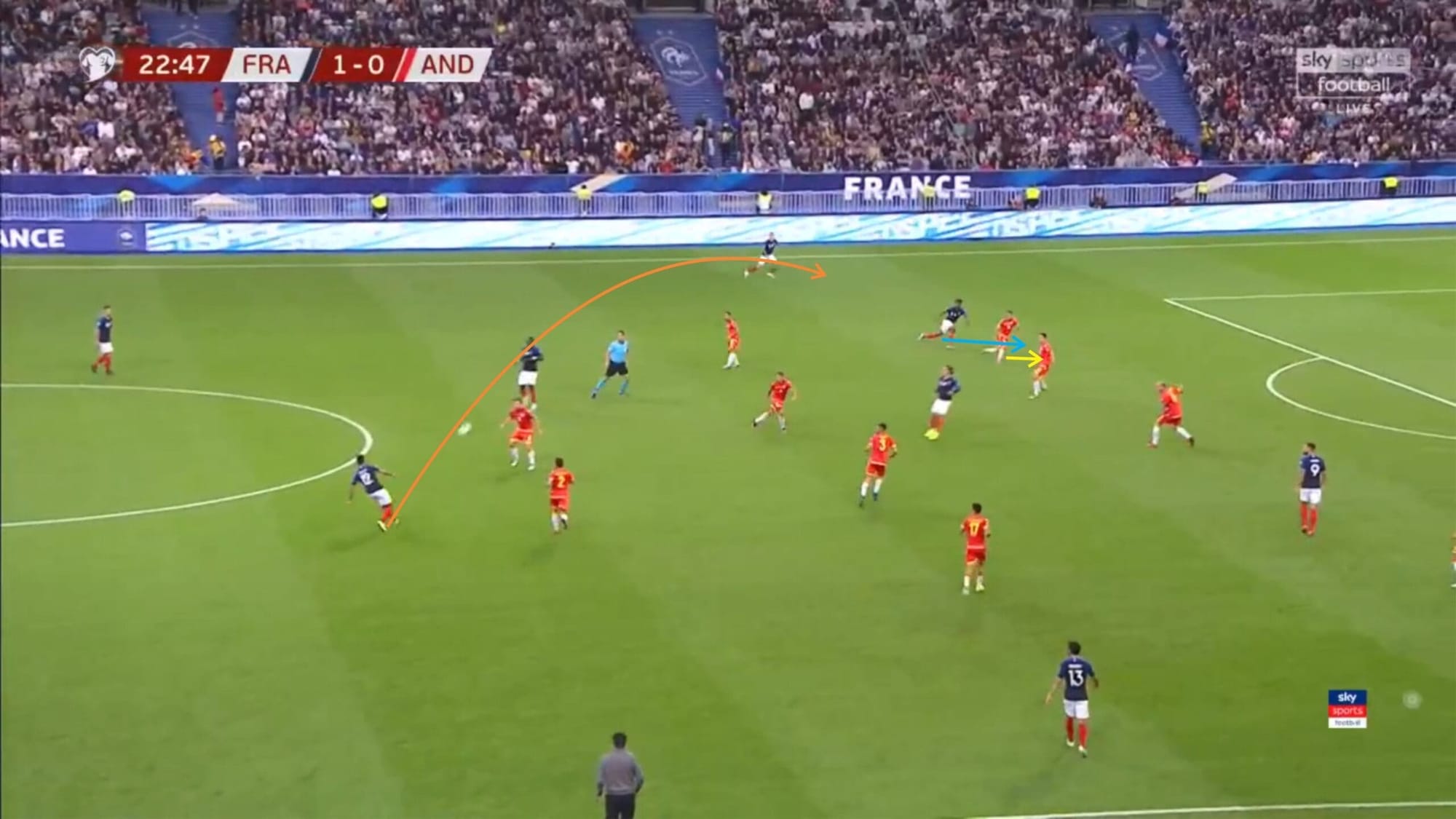
This picture above is how France managed to break through the flanks.
Tolisso played the ball to Dubois on the right flank. The latter then exchanged passes with Ikoné before returning the ball to Tolisso, who quickly moved the ball to his left and delivered a pass towards Digne who’s completely unmarked out wide on the left-hand side. Before Tolisso played the ball towards Digne, Coman saw that Tolisso was already preparing to deliver the ball and immediately made an inside run, dragging the right-back with him and subsequently freeing up Digne. Though Tolisso could have played a much riskier pass towards Coman, the Bayern Munich man decided to progress the ball a bit more safely through Digne on the left flank.
This could have been anticipated had Andorra moved quicker when their opposition were switching play. The Andorran right midfielder should have been more aware of Digne on that flank, covering the space left by the right-back.
France’s players tended to move into pockets of space, usually by positioning themselves diagonally from the ball-carrier.
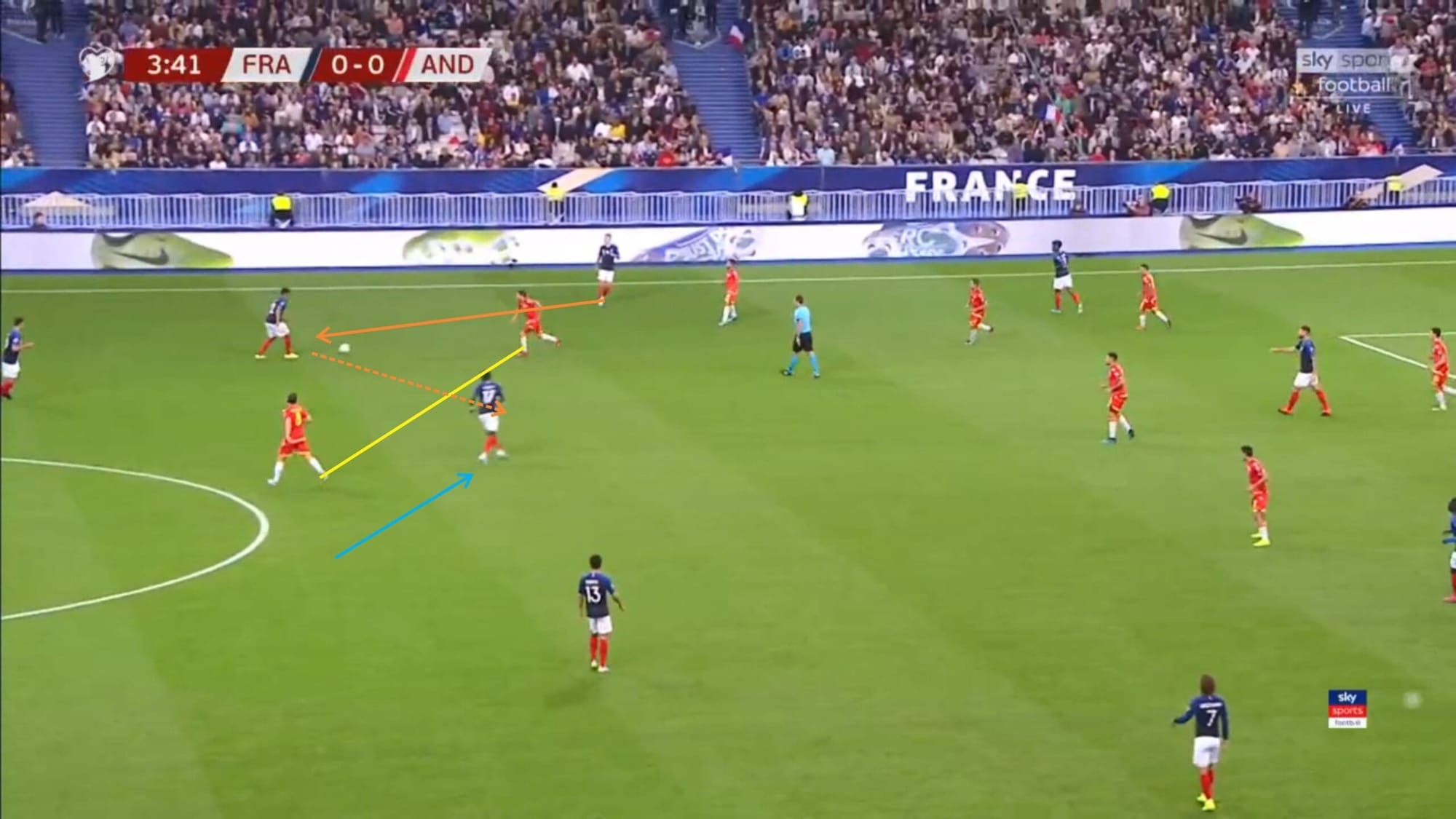
Taking advantage of the Andorran players’ lack of speed when moving and the French players’ intelligent game reading and tactical understanding, Deschamps’ side could still often advance and even breakthrough centrally, using passes between the lines or into pockets of spaces.
Like in the picture above for example, Tolisso played the ball to Digne who returned it back to Tolisso. Sissoko saw a gap between the two strikers that was created due to the right-sided striker drifting wide to create an overload and positioned himself there to offer a passing option. Tolisso passed the ball to Sissoko who, unfortunately, didn’t manage to progress the ball any further in the end.
Though pretty much capable of producing danger from any part of the field, France were usually more dangerous when they’re advancing through the centre. There were several times that they managed to get through their opposition’s lines and almost broke through the centre.
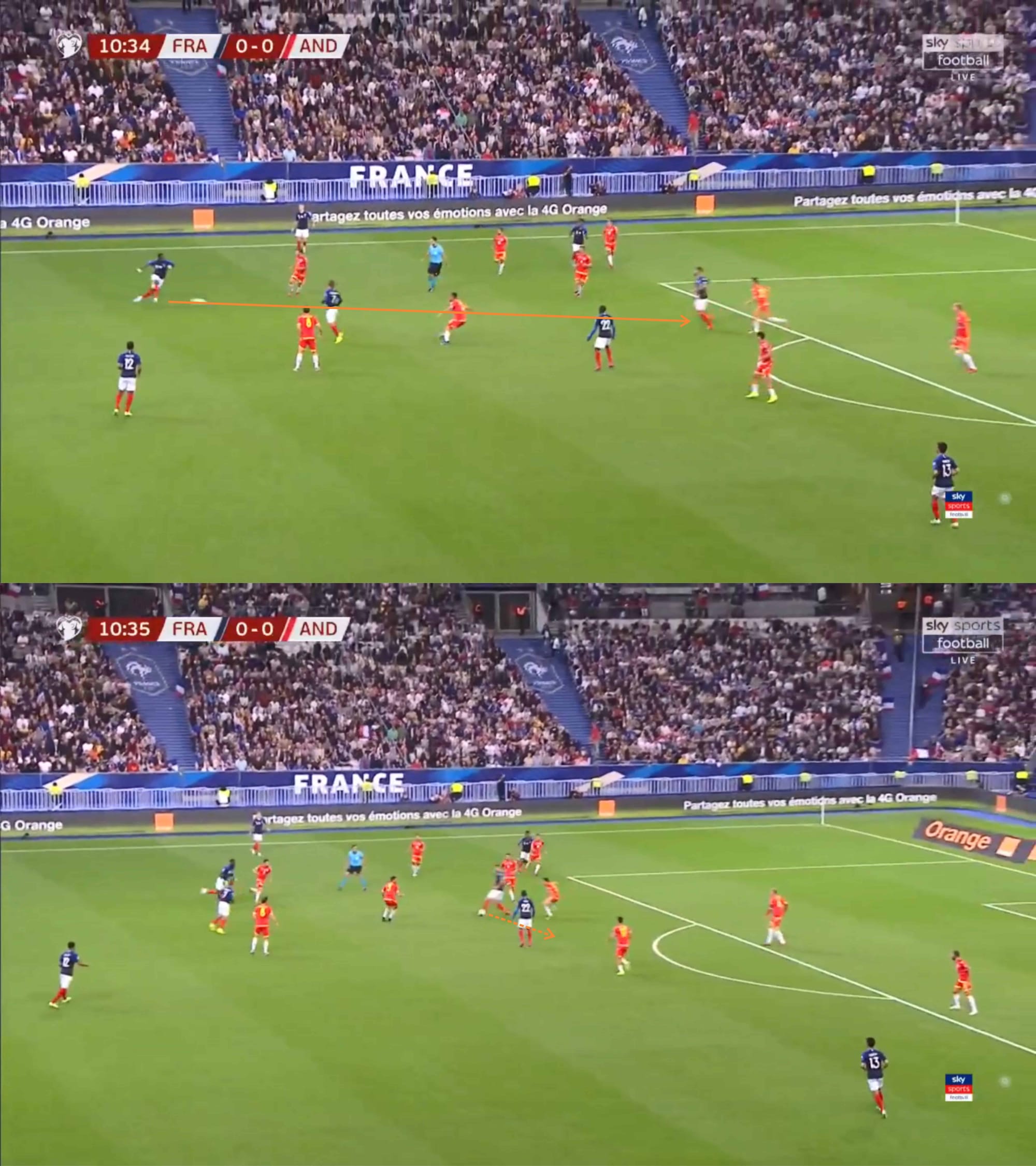
Take a look at the picture above for example. Sissoko exchanged passes with Digne on the left-hand side of the wing. Sissoko received the return pass and played a magnificent ball between the lines onto the feet of Giroud who immediately continued the ball first time towards Ikoné who sat in the centre inside the final third. The ball was a tad bit too powerful though, and the right-winger failed to get to it.
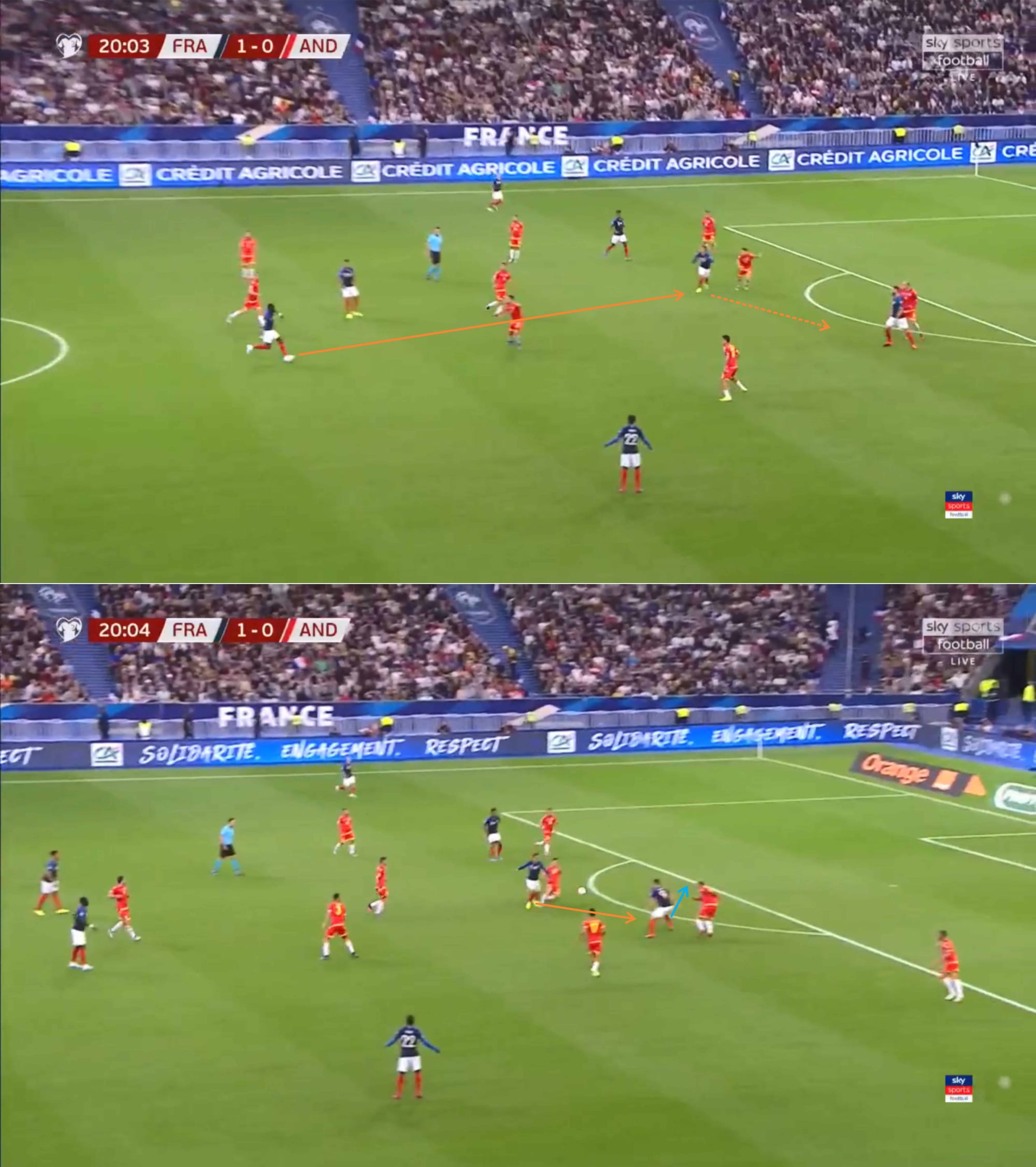
A similar situation can also be seen in the picture above. Sissoko managed to find Griezmann with his excellent vision and in turn delivered a perfectly-weighted pass past the two Andorran players. Again, same as the two previous pictures above, Griezmann quickly continued the ball with a first-time pass towards Giroud who already knew where he wanted to go. In this situation, Griezmann slightly dropped, dragging the right-sided centre-back with him, opening up some space at the back of the defence which could be exploited by Giroud. However, Giroud’s touch was poor and Andorra successfully dealt with the attack.
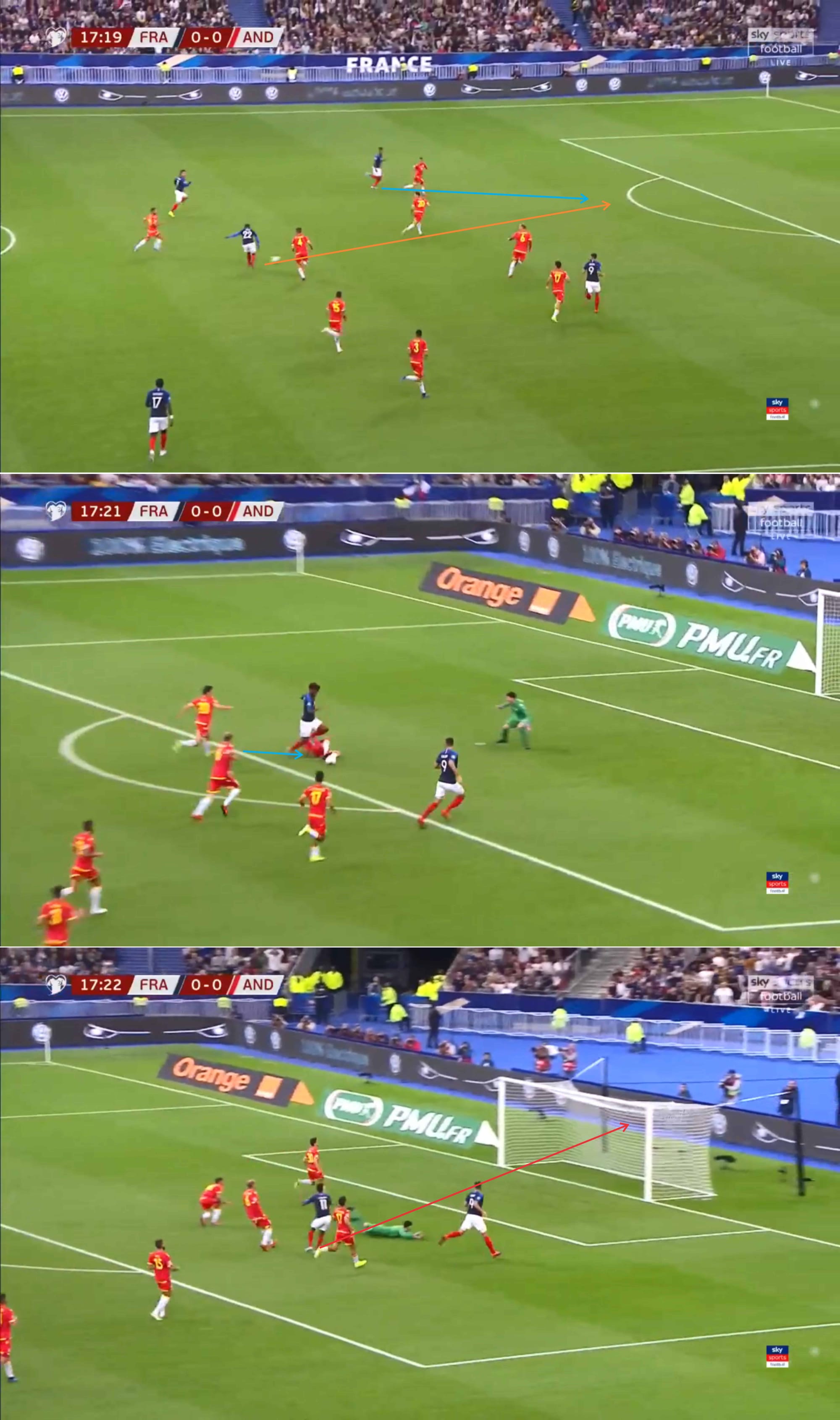
Though the first two situations above ended in vain, France finally broke through Andorra’s defence, again through the centre, however, this time a bit different.
Sissoko brought the ball to the right flank before giving it to Ikoné in the half-space. The latter then dribbled the ball inwards, triggering Andorra’s defence to start switching their focus and prepare for a switch of play. But instead of moving the ball wide, Ikoné played a splendid through ball onto the path of Coman who made an inward run from out wide. The through ball seemed to come as a surprise for the right-sided centre-back as he failed to anticipate and intercept it. Coman outran the Andorran right-back and got to the ball first. He maintained control of the ball despite a challenge from the defender, shaped himself up for a shot with his right and blasted it home for the first goal of the game.
France’s high pressure gives Andorra no chance
With France playing aggressively both in attack and defence, there just wasn’t much chance for Andorra to really build their play up and present a threat to their opposition.
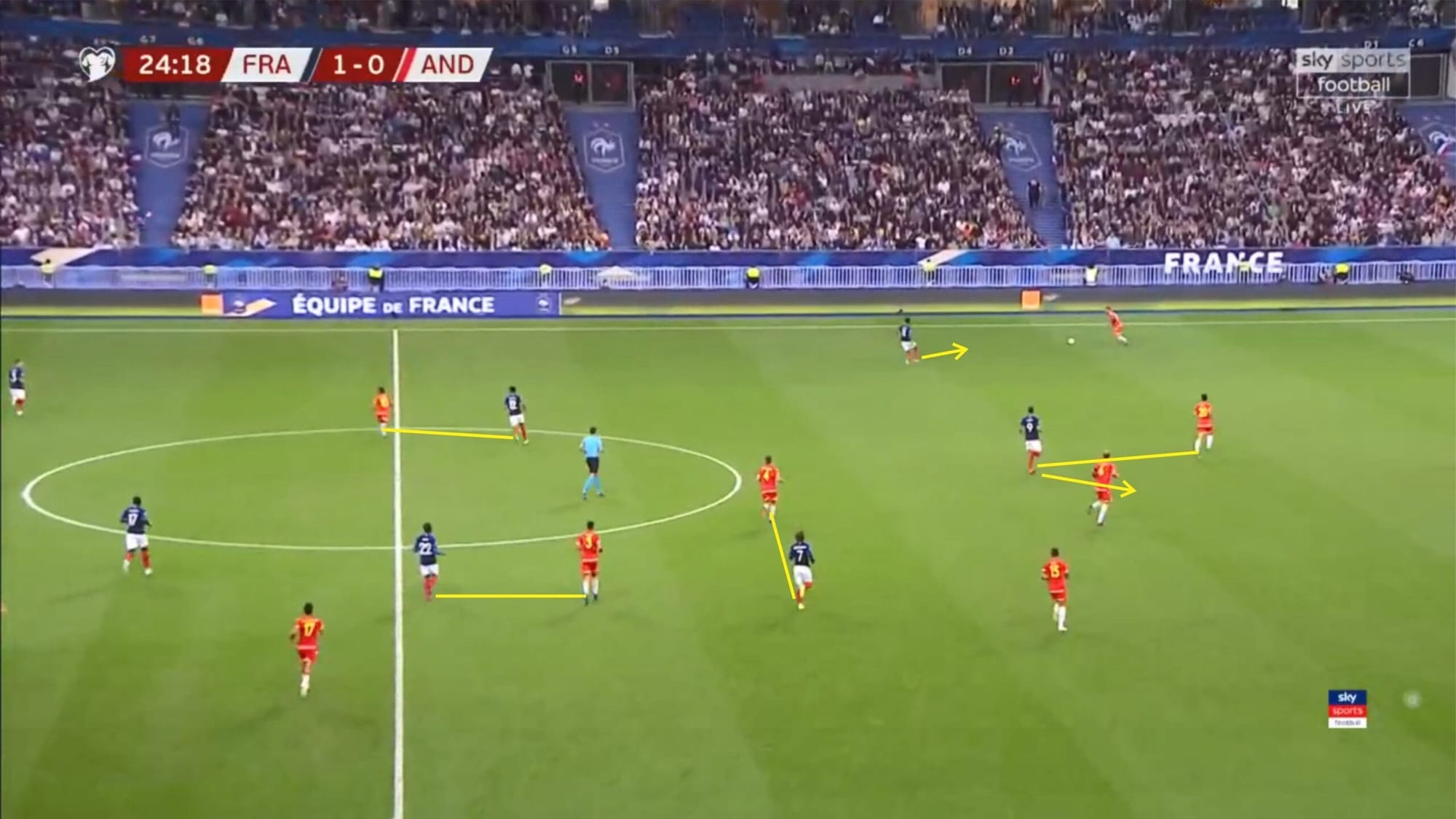
France defended with a high block. With Andorra usually quickly moving the ball to the flanks whenever possible, it was easier for France to create an overload on one side, isolate the ball-carrier, and quickly win back possession.
The picture above shows France forcing Andorra to play a long ball forward. When the ball was moved to the flank, Giroud would try to mark the passing lane to the closest defender while Griezmann marked the playmaker. With the ball-carrier’s access to the nearest players being blocked and the French winger applying pressure to the ball-carrier, he needed to take an action quickly and decided to loft it long. However, the French defenders were always there to deal with the aerial balls. The right-back knew well he may lose possession if he tried to take Coman on or if he held the ball for any longer.
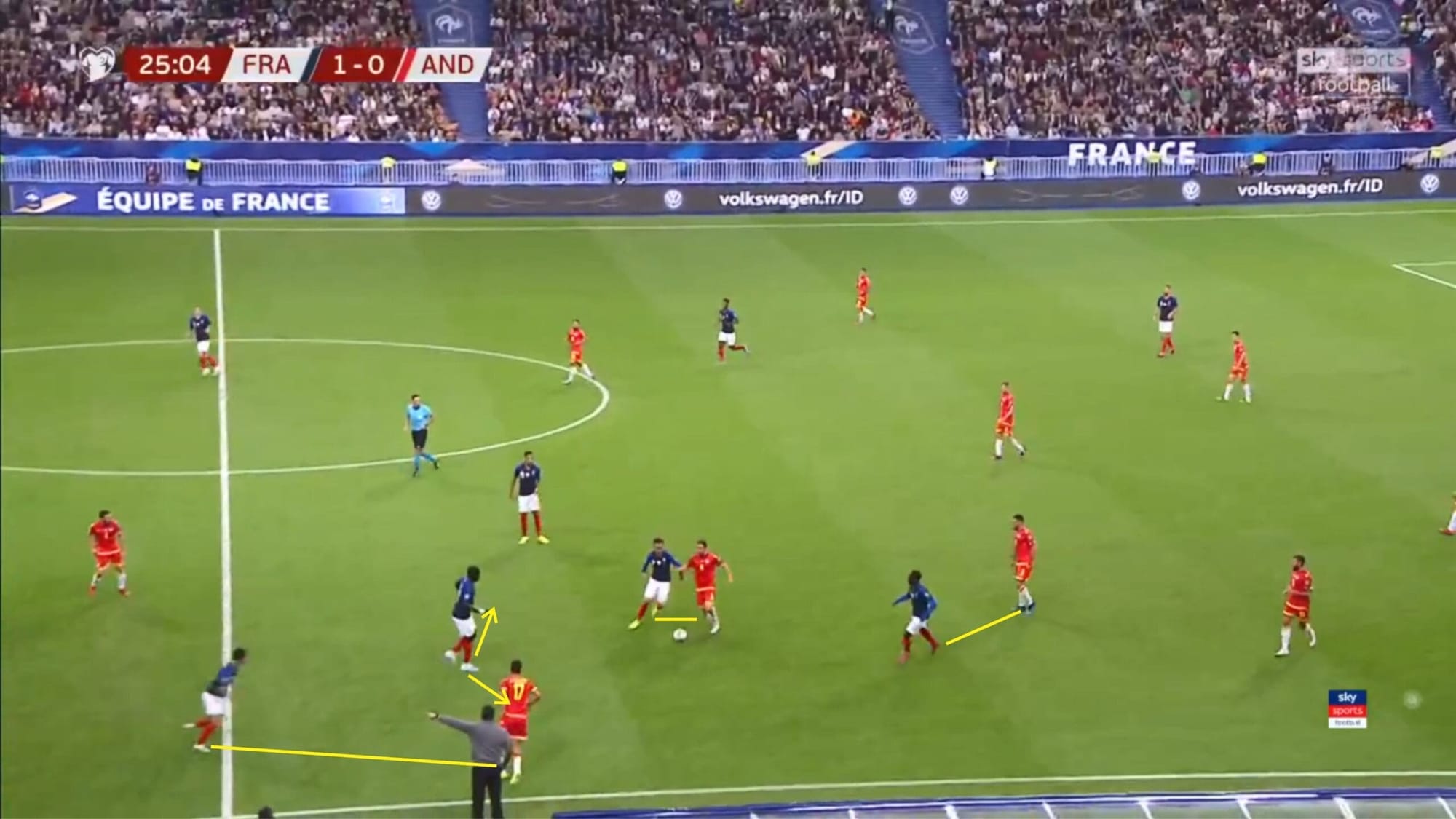
The picture above shows France’s high pressing and flank overload. As you can see, when the ball was in wider areas, France always tried to create an overload on that flank. With Griezmann tracking back and pushing the opposing player to bring the ball wide, Sissoko and Ikoné closing down and blocking the passing lane and Dubois pushing forward and anticipating a pass to the opposing wide player, France successfully compressed space, created an overload, and isolated the ball-carrier in this situation.
Conclusion
Even before the match started, everybody knew who was going to win the game. And indeed there were no surprises in the end as France managed to secure a comfortable 3-0 win, thanks to Coman’s goal from Ikoné’s through pass, Lenglet’s header from a Griezmann free-kick, and Wissam Ben Yedder’s late goal as he pounced on the rebound of a Nabil Fekir free-kick.
France completely dominated the game thanks to not only the individual quality that each player possesses but also their tactics throughout the game.

If you love tactical analysis, then you’ll love the digital magazines from totalfootballanalysis.com – a guaranteed 100+ pages of pure tactical analysis covering topics from the Premier League, Serie A, La Liga, Bundesliga and many, many more. Buy your copy of the August issue for just ₤4.99 here.

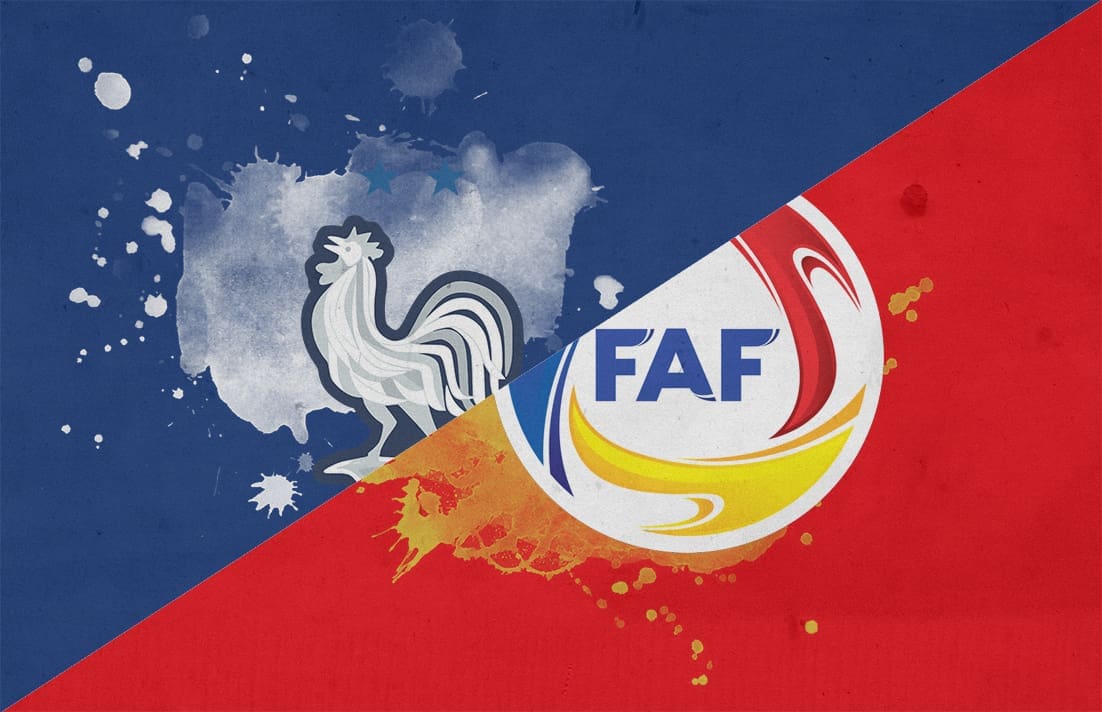

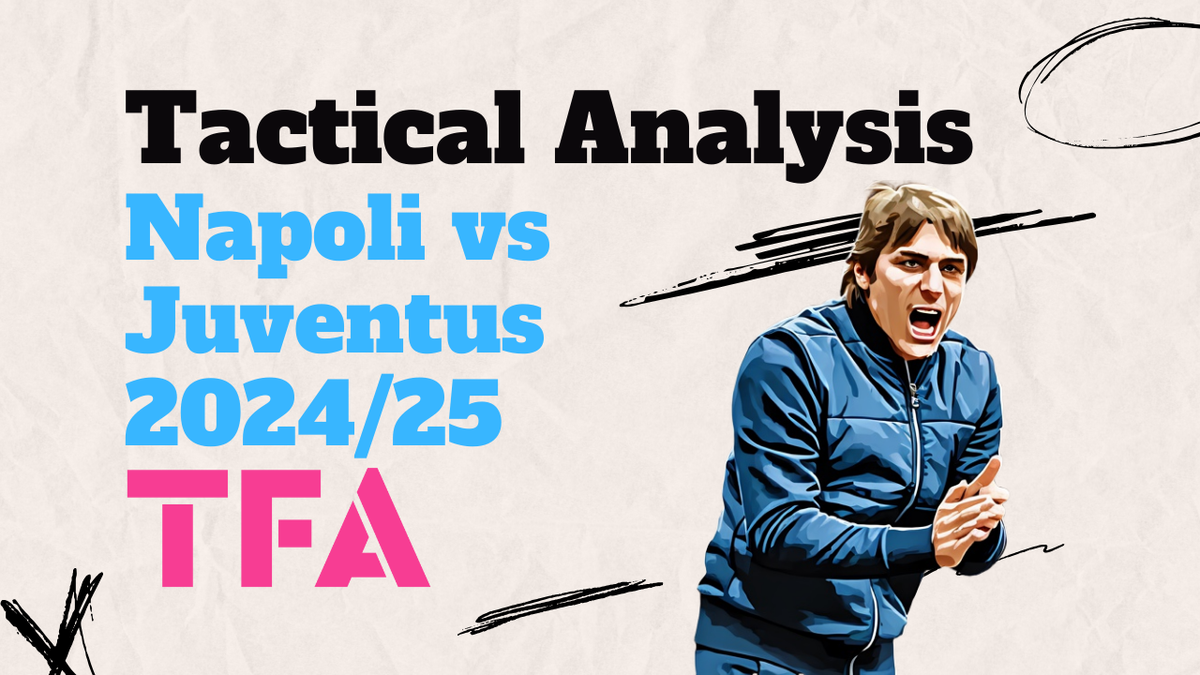
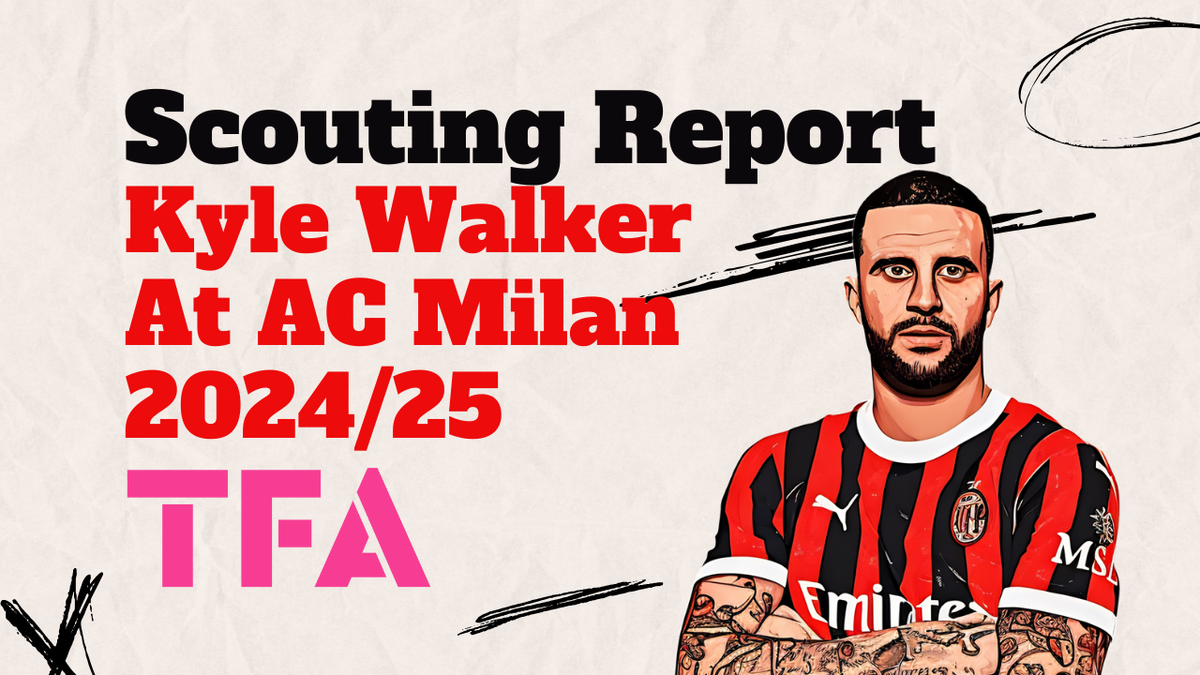
Comments